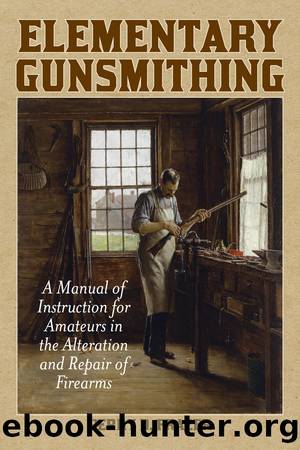Elementary Gunsmithing by Perry Frazer

Author:Perry Frazer
Language: eng
Format: epub
ISBN: 9781629149325
Publisher: Skyhorse Publishing
Published: 2015-01-01T00:00:00+00:00
A machine-inletted stock blank such as can be furnished by the National Target and Supply Company, suitable for the making of a custom stock with full, well curved pistol grip, Monte Carlo comb and beaver-tail forearm. A splendidly figured piece of wood for such a low-priced blank. It is a simple job to finish out this blank into a first-grade sporting rifle stock.
Another simple formula is made up of a 10 per cent solution of nitric acid in hot water. Dip the parts for several minutes, then put them for three successive periods, five minutes each, in fresh boiling water, to remove all traces of acid. Place on wire gauze over a flame until quite hot, then quench in oil.
Small parts like screws and pins, and even sights, may be heated until dull red in a flame, then, as the color darkens, rub with the linseed-sperm oil crude oil dope, previously mentioned. Cut down the proportion of linseed if a nice blue is wanted, otherwise a reddish-blue will result. Although it is more or less waterproof, the color is not desirable.
With this simple heat blueing watch the metal closely for color. At first this will be deep purplish-blue, then this fades to a gray-blue, to red, at which time it should be taken out and held until the color darkens, then wiped steadily with the oil-soaked cloth. This is very satisfactory for screws and pins, not for large parts. Lacking a screw to match a metal part nicely, take a common wood screw, set it in the chuck and with a file round the head evenly, smooth off the sharp edge, then blue by heat. This makes a nice job when nothing better is at hand. It works well with grip-caps and such things.
Blueing is not all pure joy. Much depends on the sort of steel being worked on, atmospheric influences, kind of water, etc. Read Mr. Angierâs comments of various solutions. Very often a barrel and its receiver will react differently, one taking color nicely, the other coming out anything but satisfactory. Some old receivers are so rusted or scratched, through long use, that the amateur cannot tell, until he has tried repeatedly, how the metal was last treated. A carbon steel barrel will not be difficult to blue, but a stainless barrel may not take the color worth a hoot. Water varies. If distilled water could be made available, some common troubles might be avoided, but the best most of us can do is to use rainwater or melted snow, and trust to luck. In theory, at least, that should be pure, unless the water or snow is contaminated on its way to the containers we use in collecting it. It must be remembered that blueing is a chemical process and much depends on the exact composition of the water one uses. A formula that will work nicely in my shop may not be at all good in the State of Washington.
Blueing is so simple, and so satisfactory when well done, that every young smith should practice it thoroughly.
Download
This site does not store any files on its server. We only index and link to content provided by other sites. Please contact the content providers to delete copyright contents if any and email us, we'll remove relevant links or contents immediately.
On Writing A Memoir of the Craft by Stephen King(4252)
The Doodle Revolution by Sunni Brown(4070)
A Simplified Life by Emily Ley(3597)
Mummy Knew by Lisa James(3181)
Marijuana Grower's Handbook by Ed Rosenthal(3144)
Paper Parties by Erin Hung(3051)
Better Homes and Gardens New Cookbook by Better Homes & Gardens(2980)
Figure Drawing for Artists by Steve Huston(2818)
Draw Your Day by Samantha Dion Baker(2726)
The Genius of Japanese Carpentry by Azby Brown(2630)
Japanese Design by Patricia J. Graham(2577)
Lions and Lace by Meagan Mckinney(2511)
Dangerous Girls by Haas Abigail(2499)
The Curated Closet by Anuschka Rees(2409)
How to Make Your Own Soap by Sally Hornsey(2365)
Zero to Make by David Lang(2357)
The Wardrobe Wakeup by Lois Joy Johnson(2247)
The Code Book by Simon Singh(2238)
The Checklist Manifesto by Atul Gawande(2223)
